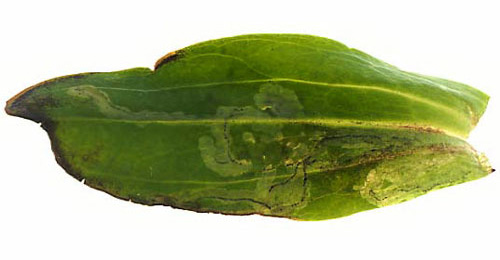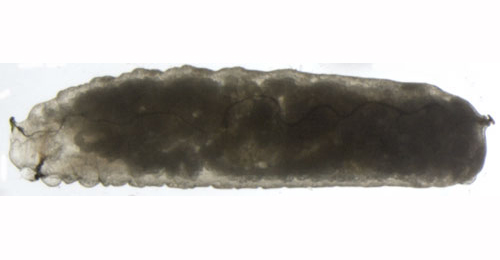|
||||||
Chromatomyia
gentianae (Hendel, 1920) |
||||||||||||||||||||||||||||||||||||||||||||||||||||||||||||||
|
Phytomyza
gentianae Hendel, 1920. Arch. Naturgesch. 84A(7)
(1918): 163 |
||||||||||||||||||||||||||||||||||||||||||||||||||||||||||||||
Leaf-mine: The mine begins as a small upper-surface blotch, from which corridors radiate. Wile these become longer and more numerous a secondary blotch develops. Frass in pearl strings. Pupation within the mine (Bladmineerders van Europa).
Larva: The larvae of flies are leg-less maggots without a head capsule (see examples). They never have thoracic or abdominal legs. They do not have chewing mouthparts, although they do have a characteristic cephalo-pharyngeal skeleton (see examples), usually visible internally through the body wall. Posterior spiracles with 8-9 bulbs. The larva is illustrated in Bladmineerders van Europa.
Puparium: The puparia of flies are formed within the hardened last larval skin or puparium and as a result sheaths enclosing head appendages, wings and legs are not visible externally (see examples). Comments: Spencer (1972b: 95) recorded Chromatomyia gentianae (as Phytomyza) on Blackstonia perfoliata and Centaurium erythrae (as minus). However, he later (Spencer, 1990: 396-7) recognised that specimens on Blackstonia perfoliata and specimens on Centaurium erythrae represented two different new species, which he described as Chromatomyia blackstoniae and Chromatomyia centaurii respectively. Hosts in Great Britain and Ireland: Currently unknown. Hosts elsewhere:
Time of year - mines: July and August-September (Bladmineerders van Europa). Time of year - adults: Currently unknown. Distribution in Great Britain and Ireland: Currently unknown. Distribution elsewhere: All confirmed records so far are from the mountains of central Europe (Spencer, 1990). Also recorded in The Netherlands (Bladmineerders van Europa), Austria, Bulgaria, Czech Republic, French mainland, Germany, Italian mainland, Lithuania, Poland, Slovakia, Spanish mainland, Switzerland and The Netherlands (Fauna Europaea). NBN Atlas links to known host species: British and Irish Parasitoids in Britain and elsewhere:
|
|
|
|
| External links: | Search the internet: |
Biodiversity Heritage Library |
Find
using Google Find using Google Scholar Find images using Google |
| Last updated 09-Jul-2019 Brian Pitkin | ||


